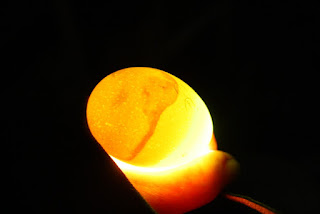 |
| Hatching Eggs |
Well my first incubator hatch came off so successful that I decided to do some more eggs. I bought some that were shipped to me. Shipping lowers the hatch rate because the eggs tend to get scrambled by the PO, even when marked FRAGILE. The pale green eggs were in a box, marked fragile and one corner of the box was crushed in. The eggs were well packed, each egg individually wrapped in bubble wrap, placed in a smaller box in the center of the big box with more packing between the two boxes. Even so the egg closest to the crushed corner was cracked. The orange blob is some crayon was I melted over the crack to help keep out bacteria, just in case the egg actually was able to grow. Those pale green eggs are from chickens called Easter Eggers, which is not a standardized breed of chicken, but crosses between Ameraucauna and other breeds. Also, Amercauna chickens that are not up to the Standard of Perfection and cannot be shown, are also referred to as Easter Eggers or EEs, even if they are purebred. (confused yet?)
Those dark brown eggs are from French Black Copper Marans, a breed that comes from Marans, France. The darkest of the eggs in this pic are the lightest allowed in the breed and I have seen pictures of some that were so dark they were pushing towards black.
The 7 light brown eggs are from my banty hens and my big Buff Orpington rooster. I put all these eggs in the incubator on Oct 25. Today is Day 9. I finally got a really bright LED flashlight to use for candling the eggs. Candling is where you shine a light through the egg so you can see what is going on inside of it. I am still learning to candle, so unless I am really sure the egg is a dud I leave it in the incubator. I'm afraid I will toss one that was actually still good in my inexperience.
 |
| scrambled egg |
This one was definitely scrambled, that blood ring goes all the way around the egg, pulled 4 EE and 2 Marans that looked like this.
 |
| chick embryo |
See that red dot in the middle of this one? that's the head of the embryo, the fainter squiggle below it is it's body. You can also see the network of veins that draw nutrients from the egg yolk to feed the developing chick. This little guy was jumping and swimming all over the place.
Most of the Marans eggs are too dark to candle, but at least one showed definite signs of life. Some of the EEs were also lively and all seven of the banty eggs were jumping for joy!
The eggs are due to hatch November 15. So yea, think we'll end up with chicks in the living room all winter....
I didn't realize there was so many different kinds pf chickens and that there was so much to learn about all this. Nancy
ReplyDeleteThis is fascinating! I had no idea you could see all the activity going on in an egg. I know next to nothing about raising chickens and I really enjoyed reading this. November 15 will be a happy day at your house, huh? :>}
ReplyDeleteOH yeah, hundreds of breeds, bred for different climates, purposes and management techniques! so much fun. My main interest is eggs to sell, meat for me, birds that at least are pretty close to the Standard of Perfection so I can sell them to 4H kids that are going to show. Also to help heritage breeds stay around and not go extinct.
ReplyDelete